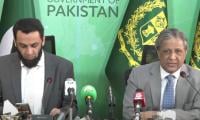KARACHI: The country’s trade deficit widened to whopping $23.963 billion in the last fiscal year of 2015/16 with exports falling more sharply than the imports, the official data showed on Friday.
The Pakistan Bureau of Statistics (PBS) data showed that this deficit was 8.14 percent up as compared to $22.159 billion in the fiscal 2014/15.
Exports decreased 12.11 percent to $20.802 billion in 2015/16, while imports inched down 2.32 percent to $44.765 billion.
The government further recorded a significant 29 percent increase in the trade deficit to $2.816 billion in June over May. The gap between exports and imports widened 10 percent in the last month of the previous fiscal over the same month a year ago.
In June, exports fell 9.88 percent to $1.651 billion over May, whereas imports rose 11.45 percent over the similar month a year earlier. Year-on-year, exports also decreased 8.73 percent and imports increased 2.27 percent.
Textile industry, which fetches more than half of the total exports revenue in the country, continues to face a cut in its share in the global trade.
An estimate says the country’s share in the world’s textile and clothing trade declined to 1.66 percent from 2.2 percent a decade ago.
Comparatively, India’s textile and clothing exports share increased to 7.55 percent, while Bangladesh’s share is more than Pakistan.
The policymakers, as a ritualistic exercise, bring forward strategic trade policy frameworks to increase exports and manage imports. However, they fail to implement the pro-growth policies.
The government is not ready to learn lessons from the past failures. The country couldn’t be able to capitalise on the opportunities presented by the generalised scheme of preferences plus status awarded by the European Union.
The failure has a root in the industry’s lackluster response in investment for expansion and modernisation.
The World Trade Organization (WTO), in its trade policy review, said the textile production is also concentrated in the preliminary processing stages and dominated by cotton textiles, clothing, and synthetic fibres. Value addition is imperative to compete with the regional competitors, especially Bangladesh.
The government should stop or at least regulate the exports of cotton and yarn.
Even the current Strategic Trade Policy Framework (2015-18) holds no strategies for the exports diversification, which has been a mantra for over many years. But, the government could not do practically in this direction with textile exports still the key foreign exchange spinner.
The WTO said Pakistan's exports continue to be heavily concentrated, with agriculture, textiles and clothing accounting for over three fourths of total exports.
In the wake of works on China-Pakistan Economic Corridor projects, imports will continue to rise. The government can, however, manage imports by encouraging development of local industries. The falling international oil prices gave an opportunity to curtail import bills.
Free trade agreement with China has largely been in Pakistan’s disadvantage.
The government needs to revisit its policies for the trade pacts with other countries as well.
Despite cautious liberalisation, overall tariff levels remain high, which weakens productivity growth and constitutes an impediment to efficient resource allocation and the integration of Pakistan into global value chains,” it said.
Chinese power company had intended to acquire up to 18.336 billion ordinary shares of K-Electric, representing 66.4...
MARI also successfully drilled and tested another appraisal well in the Mari Ghazij formation located in Mari D&PL
Gold rates decreased by $30 to $2,381 per ounce in the international market
Growing number of Americans have seen their savings dwindle as rising prices squeeze budgets while interest rates stay...
IMF will closely watch the privatization of PIA by the end of June
PSX lays down the groundwork to encourage listed companies to adopt ESG reporting in line with global standards







